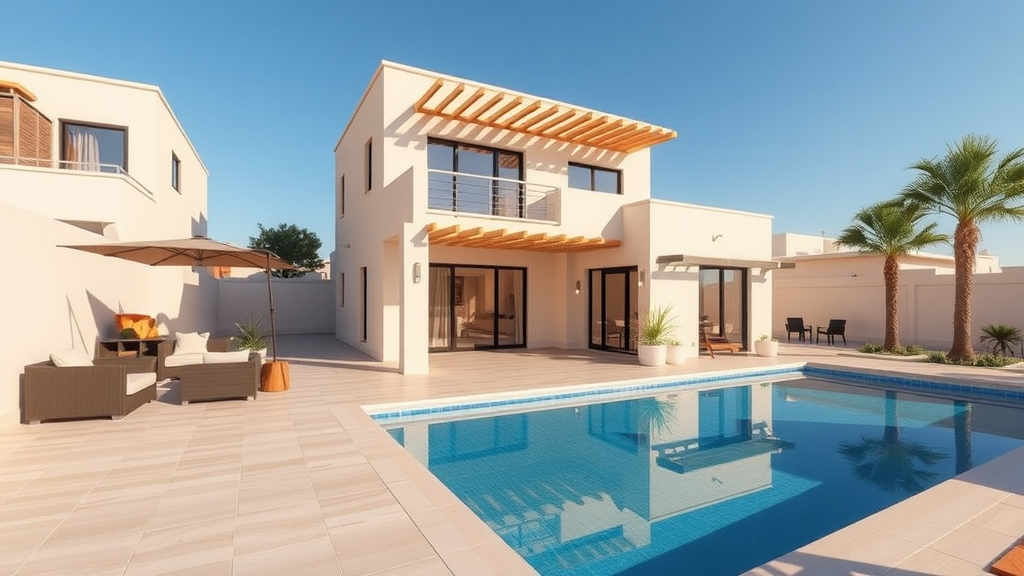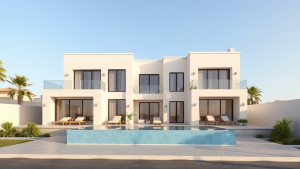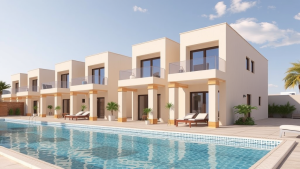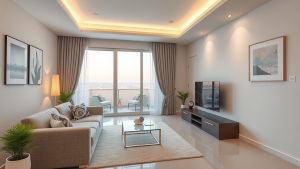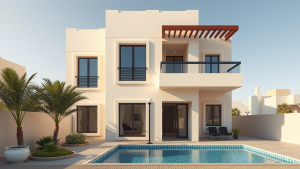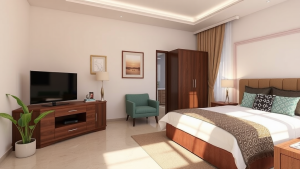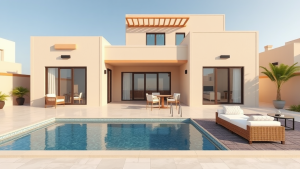Essential accessible home features every retiree should consider
As you enter retirement, your home becomes more than just a place to live; it’s your sanctuary. Ensuring your home is accessible can significantly improve your comfort, safety, and overall quality of life. Here are some essential accessible home features you should think about incorporating.
Wider doorways and hallways
One of the first considerations for accessibility is the width of doorways and hallways. Standard door widths can sometimes be a tight squeeze for those using mobility aids like walkers or wheelchairs. Aim for doorways that are at least 32 inches wide, as this allows for easier navigation throughout the home. Hallways should be similarly spacious, ideally at least 36 inches wide, making it simple to move freely and safely.
Non-slip flooring
Your choice of flooring can have a huge impact on your safety at home. Many materials can become slippery, especially when wet. Consider non-slip tiles, vinyl, or low-pile carpet for areas where slips are more likely, such as kitchens and bathrooms. Rugs should have non-slip backing or be secured to prevent tripping.
Accessible bathrooms
Bathrooms are vital spaces to make accessible. Consider the following features:
- Grab Bars: Installed near the shower, toilet, and bathtub, grab bars provide support and stability.
- Walk-In Showers: A shower with a low threshold or no threshold is recommended. A fold-down bench can add extra safety and convenience.
- Raised Toilets: Higher toilets can ease the strain on knees and backs, making them easier to use.
- Lever Faucets: These are easier to operate than traditional knobs, which can be difficult for those with limited hand strength.
Kitchen accessibility
The kitchen should also be user-friendly. Here are some features to consider:
- Lower Counter Heights: Countertops that are at elbow height can make food preparation tasks less straining.
- Pull-Out Cabinets: Easy-to-access cabinets that pull out can help you reach items without bending down excessively.
- Side-by-Side Refrigerators: These are easier to access than top-freezer models, as they make it simple to grab items without stretching or bending.
Lighting considerations
Proper lighting can dramatically enhance safety and comfort in your home. Be sure to:
- Install Bright LED Lights: These provide clear visibility, making it easier to navigate.
- Add Task Lighting: Consider pendant lights above work areas, like the kitchen island or reading nooks, to illuminate these spaces effectively.
- Include Motion Sensors: Lighting that turns on as you enter a room can help prevent falls during the night.
Smart home technology
Embracing technology can also contribute to a more accessible environment. Smart home devices can simplify daily tasks and enhance safety. Think about:
- Voice-Activated Assistants: Systems like Amazon Alexa or Google Home can control lights, locks, and other devices with simple voice commands.
- Smart Doorbells: These allow you to see and communicate with visitors without needing to open the door.
- Home Security Systems: Features that include cameras or alarms can provide peace of mind, which is essential during retirement.
Outdoor accessibility
Don’t forget about your outdoor spaces. Safe, accessible outdoor areas can enhance your enjoyment of your home. Here are some suggestions:
- Level Paths: Ensure walkways are smooth and even, minimizing tripping hazards.
- Ramps: Instead of stairs, consider ramps for ease of access. Railings can also help for added stability.
- Seating Areas: Create comfortable spots for rest to enjoy the outdoors without overstressing your body.
Investing in accessible home features is not just about convenience; it’s about creating a space that supports your lifestyle during retirement. By prioritizing accessibility, you are ensuring your home remains a safe and enjoyable haven throughout your golden years.
The financial benefits of investing in accessibility for seniors
Accessibility features in homes for seniors not only enhance comfort but can also lead to significant financial benefits. As you age, investing in accessibility can protect your financial future and provide a safer and more enjoyable living experience. Here’s what you need to know about the financial perks of making your home more accessible.
Enhancing property value
One of the most straightforward financial benefits of adding accessible features in your home is the potential increase in property value. Many homebuyers today are looking for properties that accommodate aging in place, so accessibility features can make your home more attractive to a broader market. Consider the following enhancements:
- Wider doorways and hallways for wheelchair accessibility.
- Grab bars in bathrooms and kitchens for safety.
- Ramps instead of stairs to ease mobility.
- Lever-style door handles that are easier to use.
These features not only make life easier for you but can also provide a good return on investment if you decide to sell your home later on.
Reducing healthcare costs
Investing in accessibility can also lead to lower healthcare costs. By making your living environment safer, you are less likely to experience falls or injuries, which can lead to expensive hospital visits or long-term care needs. Here are a few ways accessibility helps:
- Non-slip flooring reduces the risk of falls.
- Walk-in tubs and curbless showers minimize accidents in the bathroom.
- Better lighting can help prevent trips and falls.
By prioritizing accessibility, you can decrease your chances of health issues, which may save you money in the long run.
Avoiding relocation costs
Many seniors face the difficult decision of moving to assisted living facilities as they age. However, with an accessible home, you might find it easier to remain independent. Staying in your current home reduces costs related to moving, such as:
- Real estate agent fees.
- Renovation costs for the new residence.
- Moving expenses, including hiring trucks and labor.
Staying where you are also allows you to maintain established community ties and social networks, which can improve your overall well-being.
Potential tax benefits
Investing in accessibility features may qualify you for certain tax deductions. According to IRS guidelines, if you modify your home for medical purposes, you could deduct these expenses on your tax returns. This includes:
- Costs of constructing ramps and other modifications.
- Installing equipment such as stairlifts.
- Renovations aimed at enhancing mobility and safety.
Consult a tax professional to understand what qualifies and how you can maximize your deductions.
Financial aid and grants
Numerous programs exist to help seniors pay for accessibility modifications. Look for grants or financial aid that your state or local government may offer. Some resources to explore include:
- Program for All-Inclusive Care for the Elderly (PACE).
- Community Development Block Grant (CDBG) programs.
- Nonprofit organizations focused on senior living.
These programs can alleviate the financial burden while ensuring your home is safe and accessible.
Insurance benefits
Having accessibility features in your home might also influence your homeowner’s insurance premiums. Insurance companies may provide discounts for homes with certain safety features. Enhanced safety measures can lead to a lower risk of claims, making you a more attractive client:
- Non-slip floors.
- Smoke detectors and security systems.
- Fall prevention modifications.
Discuss with your insurance agent to determine any potential discounts available to you.
Adopting accessible home features as a senior is not merely about comfort and security; it’s a strategic financial decision that can lead to long-term savings. Investing in your home today can pay off in numerous ways, ensuring you remain healthy, safe, and financially secure as you age.
Making your home accessible is a critical step for retirees aiming to age gracefully in place. By focusing on essential accessible home features, such as wide doorways, grab bars, and non-slip flooring, you can create a comfortable environment that promotes independence and safety. These features not only help reduce the risk of accidents but also encourage a more enjoyable living experience.
Investing in accessibility is not merely a matter of immediate comfort; it also offers significant financial benefits. Home modifications can enhance your property’s value and appeal, making it an attractive option for potential buyers in the future. Additionally, financial assistance programs may help offset initial costs, allowing you to prioritize your well-being without straining your budget.
By taking proactive steps to incorporate accessible home features, you’re not only preparing your living space for possible physical challenges but also ensuring a better quality of life. This proactive approach pays off, as it allows for seamless transitions as needs change over time.
As you consider these modifications, remember that your home should reflect your style and meet your needs. Whether you are seeking small updates or larger renovations, every adjustment contributes to a safer, more enjoyable living experience. Prioritizing accessibility is more than just a trend; it’s a smart, long-term investment in your quality of life as you enter this new and exciting chapter of retirement. Embrace the opportunity to create a home where you can thrive for years to come.
Last offer – exclusive 3 bedroom villa in sahel hasheesh Hurghada under 150k — homes for polish winter escapers
17% off – spacious 1 bedroom villa with swimming pool in sahel hasheesh Hurghada under 50k — perfect for german couples

